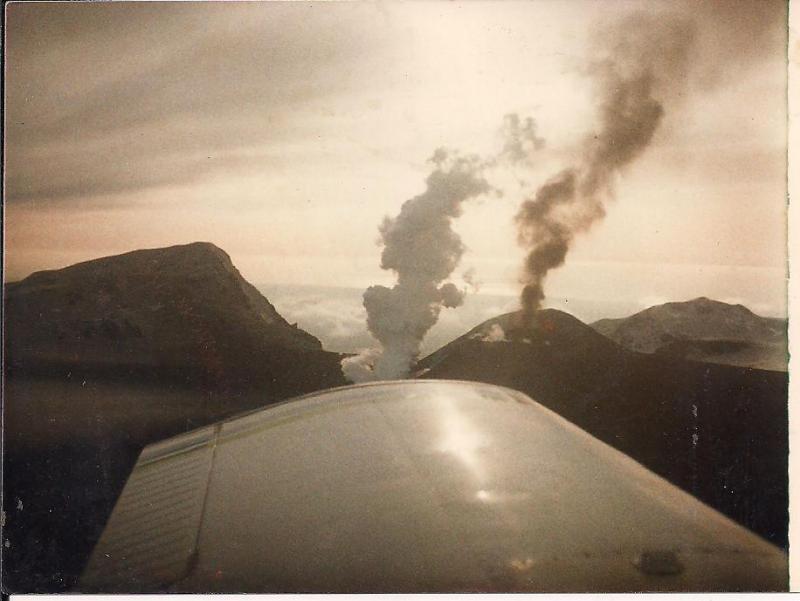
Photo of Veniaminof during 1983 eruption. Photo courtesy of Greg Gallant.
Volcano(es): Veniaminof
Photographer: Gallant, Greg
URL: avo.alaska.edu/image/view/75021
Veniaminof 1983/6
From Yount and others (1985): "The more prominent of the two visible intracaldera cones of Mount Veniaminof went into eruption in early June 1983 and continued until early April 1984.
"* * * In this recent eruption, Perryville residents first saw puffs of ash on June 2, 1983. Early manifestations of the Strombolian eruption included a 90-m-wide sector graben and a circular depression (400 m in diameter and approximately 30 m deep) in the glacial-ice surface directly south of the active cone. By June 9, the 300-m-deep crater of the cone had filled to overflowing with juvenile bombs, blocks, and rising magma, resulting in a lava flow from a low point on the southwest side. The lava flow and subglacial heating caused rapid melting of the glacial ice on the south side of the active cone. By July 13, a vertical-walled, bilobate pit measuring approximately 1,300 m in the east-west direction, 400-800 m in the north-south direction, and 60-100 m deep had formed in the ice. The pit contained a lake of unknown depth and a southward-building lava delta. A subglacial tunnel in the ice-wall at the east end of the lake indicated drainage eastward along the caldera floor. Another tunnel, less clearly observed, may have drained from the northwest end of the lake toward a breach of the caldera wall at Cone Glacier.
"Ash emission was almost continuous during June and July 1983; occasional plumes were estimated to have been as high as 7,800 m. During this time, ash blanketed the intracaldera glacier and steam plumes occurred nearly continuously. The eruption appeared to wane from mid-August to early October, through this may be partly a function of paucity of reports and observations.
"Renewed activity was reported in early October. By this time the ice-pit lake had diminished to a small pond located between the wall of the ice pit and a new lava flow lobe. The October 1983-March 1984 eruptive phase was characterized by less ash emission and more lava flow activity than the June-August 1983 phase. A succession of flows from the southwest side of the cone resulted in a continual increase in volume and height of new lava in the ice pit, and the pit enlarged slightly in plan, losing its bilobate shape. Each flow lobe cooled rapidly due to the 1,800-m elevation and winter winds; snow was observed on lobes approximately a month old. Perryville residents observed incandescent lava fountaining up to an estimated 100 m above the cone on January 23, February 6 and 13, and March 2 and 3, 1984. Fountaining was intermittent, lasting one-half to one hour and was followed by quiescent periods of at least 45 minutes. Incandescent glow was last observed March 16, 1984. From mid-March to late April, activity was limited to continual emission of small steam plumes and rare ash bursts lasting up to two hours. An observation flight on April 11 revealed that all lava-flow lobes in the pit were dusted with snow."
The Smithsonian Institution Scientific Event Alert Network Bulletin, volume 5, number 1 reports that USGS personnel estimated that approximately 45x10^6 cubic meters of lava filled the ice pit between June, 1983 and January, 1984.
Use Restriction: Please cite the photographer when using this image.
Full Resolution.